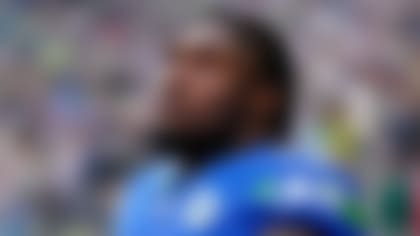The goal was to look at how premier underclassmen returning to school can hurt or help themselves with an extra season of college football. The backdrop was Matt Barkley's situation. Little did I know, it really shouldn't have been.
"I don't think Barkley really hurt himself," an AFC college scouting director said, assessing the quarterback's decision to return to USC for his senior year. "He was the same guy last year. He didn't start falling in October, no matter where he was on everyone's 'big board' in December. I looked at Barkley (after his junior year) and I thought he was a backup quarterback. I told people, 'I'm not sold.' And it was the same thing this year. In the end, I don't think he hurt himself."
Brooks: Bucky's Big Board 3.0
Bucky Brooks updates his pecking order of the top 50 prospects in the 2013 draft, revealing some notable risers and sliders. **More ...**
A second AFC college director reached Sunday afternoon wasn't quite as direct in his assessment -- his contention was Barkley simply didn't capitalize on the chance to ascend to the top of a weak quarterback class -- but agreed in general terms that Barkley's stock really wasn't impacted all that much.
"Sometimes, kids should strike when the iron's hot, when their team's had a good season and they had good personnel around them," the second personnel man said. "In Barkley's case, we weren't that high on him this summer. Based on his junior tape, he was a second-rounder for us anyway. That's his talent. Coming back, you could argue that, with less quarterbacks this year, he should've rose to the top."
The public perception of what happened to Barkley is endemic to the divide between lines of thinking outside team facilities and inside them. In many cases, when you hear a player is "rising up draft boards," it's simply the rest of us catching up to what the decision-makers really think. And in a case like Barkley's, a high-profile athlete's ebbs and flows are much sharper in the court of public opinion than they are where it really counts.
But that doesn't mean these decisions aren't impactful. It's something Texas A&M offensive tackle Jake Matthews, Michigan offensive tackle Taylor Lewan, Alabama linebacker C.J. Mosley and UCLA linebacker Anthony Barr had to weigh before opting to stay in school for the 2013 season, rather than turning pro.
So, with the help of a handful of evaluators, here are examples from this year's class of guys who helped themselves, and others who might have been better off going to the NFL last year:
Bull Market
Dion Jordan, OLB, Oregon: He put his name in for evaluation last year, and the board told him he was likely a second- or third-round prospect. Scouts saw him as a potentially dominant pass rusher then, but the Ducks used him in myriad ways. This year, Oregon rushed him more. And Jordan played his way into the top 10.
Star Lotulelei, DT, Utah: The Utes' stud still hasn't shaken the tag some evaluators have ascribed to him -- that he'll be a two-down player in the league. But by coming back for his senior year, he showed more consistency in his play, which is important for big men going high in the draft.
Sheldon Richardson, DT, Missouri: In the 2011 campaign, the disruptive interior lineman flashed outstanding athleticism as a rotational guy and rated as a possible third-round prospect. He returned, showed more hustle in 2012, won battles against the SEC's best guards, and now is a first-round lock.
Geno Smith, QB, West Virginia: Most believe Smith would've been no better than the fifth quarterback off the board in the very strong crop of 2012. Clubs have compared him to Ryan Tannehill physically, and he could wind up going even higher than Tannehill's No. 8 draft slot.
Manti Te'o, LB, Notre Dame: This one, obviously, is tricky. Te'o proved himself to be capable of leading a high-end defense, showed big-play ability, and got himself in NFL shape. All of that was great, of course, until the wheels came off in January. But from an on-field standpoint, he helped himself.
Hugh Thornton, OT, Illinois: Thornton put his name in last year and was rated as a fifth-round guard. He came back, played left tackle as a senior, and answered a lot of the questions NFL folks had on him. Now, Thornton's seen as a versatile third-round prospect.
Desmond Trufant, CB, Washington: After a lackluster junior year, Trufant flirted with the idea of leaving, then decided against it. And he got better. And bigger. Playing at 175 pounds in 2011, he got into the high 180s last fall and positioned himself to prove his physical prowess to clubs this spring.
Gbajabiamila: Mock Draft

Akbar Gbajabiamila takes his first stab at projecting Round 1 of the 2013 NFL
Draft, providing a surprise right at the top. **More ...**
Larry Warford, G, Kentucky:The risk when guys return is that their play will level off and set a ceiling. Warford's an example of the flip side. His consistently ascending performance the past two years has NFL folks wanting to see more. Staying also allowed him to get to the Senior Bowl, where he shined.
Chance Warmack, G, Alabama: The story goes that Nick Saban told Warmack last year he was getting split opinions on whether he was a first- or second-round pick. So Warmack stayed. He got better -- and more consistent -- and went from being a borderline first-rounder to a top-15 pick.
Bear Market
Montee Ball, RB, Wisconsin: It's not that Ball really hurt himself -- although the concussion questions won't help -- as much as he didn't assert himself as the top back in a weak class. Tailbacks need to keep moving forward, otherwise they're seen, as Ball was, as simply burning more tread on their tires.
Landry Jones, QB, Oklahoma: When Jones burst on to the scene first as an injury replacement for Sam Bradford in 2009, and then as a full-time starter in 2010, his tools tantalized scouts. But the more they've seen, the more questions have arisen, particularly ones about his ability to stand in and take a hit.
T.J. McDonald, S, USC: After a big junior year, he was grouped with Barkley and Matt Kalil as Trojan underclassmen with decisions to make. McDonald was deployed differently in 2012, the defense collapsed, and where he was a prospective first-rounder, he's now a bit lost in a crowded safety group.
Shawn Williams, S, Georgia: Like McDonald, Williams might have benefitted from being a part of a much thinner safety class in '12. As it was, he didn't stand out like many expected he would as a Bulldog senior, and now could be there (with McDonald) in the third round.
Tyler Wilson, QB, Arkansas: Maybe the best example of the "shoulda struck when the iron was hot" guy. Wilson lost his top three receivers from 2012, then the Bobby Petrino incident happened and the team melted down. And while Wilson showed tremendous toughness hanging in, his weaknesses were exposed.
Follow Albert Breer on Twitter @AlbertBreer



